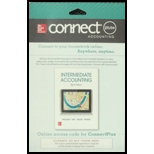
(1)
Ratio Analysis:
Ratio analysis is a tool to analyze the financial statements of a company which expresses a mathematical relationship among the items of financial statements.
To determine: The
(2)
The acid test ratio
(3)
Debt equity ratio:
Debt equity ratio is a long term solvency ratio, which expresses the relationship between own funds (shareholders’ equity) and loan funds (debt). This ratio shows the proportion of debts and shareholders’ equity to finance assets. It is calculated by dividing the total liabilities by total shareholders’ equity.
To determine: The debt equity ratio
(4)
Times interest earned ratio:
Times interest earned ratio indicates the relationship between earnings before interest and tax (EBIT) and interest expense. The purpose of the ratio is to know the payment of interest expense with respect to the company’s earnings.
To determine: The times interest earned ratio.
Want to see the full answer?
Check out a sample textbook solution
Chapter 3 Solutions
INTERMEDIATE ACCT.-CONNECT PLUS ACCESS
- I need help solving this financial accounting question with the proper methodology.arrow_forward18. Inventory shrinkage is recorded as:A. Increase in revenueB. Decrease in liabilitiesC. Inventory loss expenseD. Owner withdrawalarrow_forward19. What does a classified balance sheet show?A. Net cash from operationsB. Revenue by categoryC. Assets and liabilities in current and long-term sectionsD. Owners' drawings helparrow_forward
- I am trying to find the accurate solution to this financial accounting problem with the correct explanation.arrow_forward19. What does a classified balance sheet show?A. Net cash from operationsB. Revenue by categoryC. Assets and liabilities in current and long-term sectionsD. Owners' drawingsarrow_forwardPlease explain the correct approach for solving this financial accounting question.arrow_forward

 AccountingAccountingISBN:9781337272094Author:WARREN, Carl S., Reeve, James M., Duchac, Jonathan E.Publisher:Cengage Learning,
AccountingAccountingISBN:9781337272094Author:WARREN, Carl S., Reeve, James M., Duchac, Jonathan E.Publisher:Cengage Learning, Accounting Information SystemsAccountingISBN:9781337619202Author:Hall, James A.Publisher:Cengage Learning,
Accounting Information SystemsAccountingISBN:9781337619202Author:Hall, James A.Publisher:Cengage Learning, Horngren's Cost Accounting: A Managerial Emphasis...AccountingISBN:9780134475585Author:Srikant M. Datar, Madhav V. RajanPublisher:PEARSON
Horngren's Cost Accounting: A Managerial Emphasis...AccountingISBN:9780134475585Author:Srikant M. Datar, Madhav V. RajanPublisher:PEARSON Intermediate AccountingAccountingISBN:9781259722660Author:J. David Spiceland, Mark W. Nelson, Wayne M ThomasPublisher:McGraw-Hill Education
Intermediate AccountingAccountingISBN:9781259722660Author:J. David Spiceland, Mark W. Nelson, Wayne M ThomasPublisher:McGraw-Hill Education Financial and Managerial AccountingAccountingISBN:9781259726705Author:John J Wild, Ken W. Shaw, Barbara Chiappetta Fundamental Accounting PrinciplesPublisher:McGraw-Hill Education
Financial and Managerial AccountingAccountingISBN:9781259726705Author:John J Wild, Ken W. Shaw, Barbara Chiappetta Fundamental Accounting PrinciplesPublisher:McGraw-Hill Education





